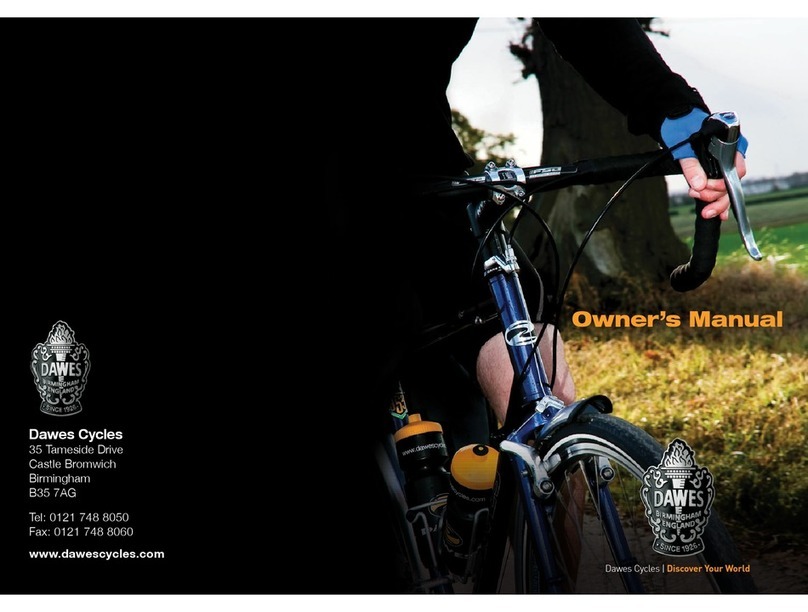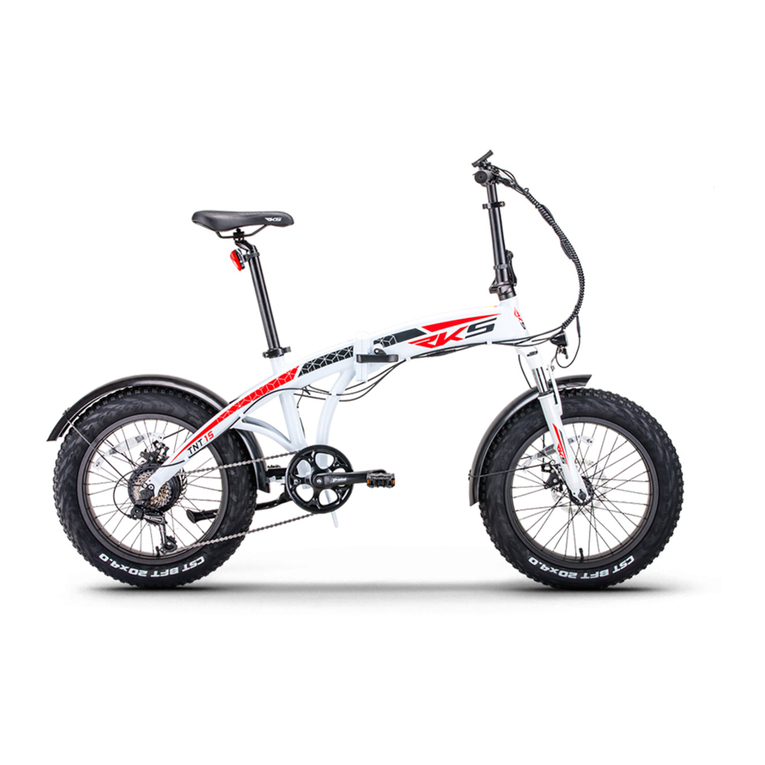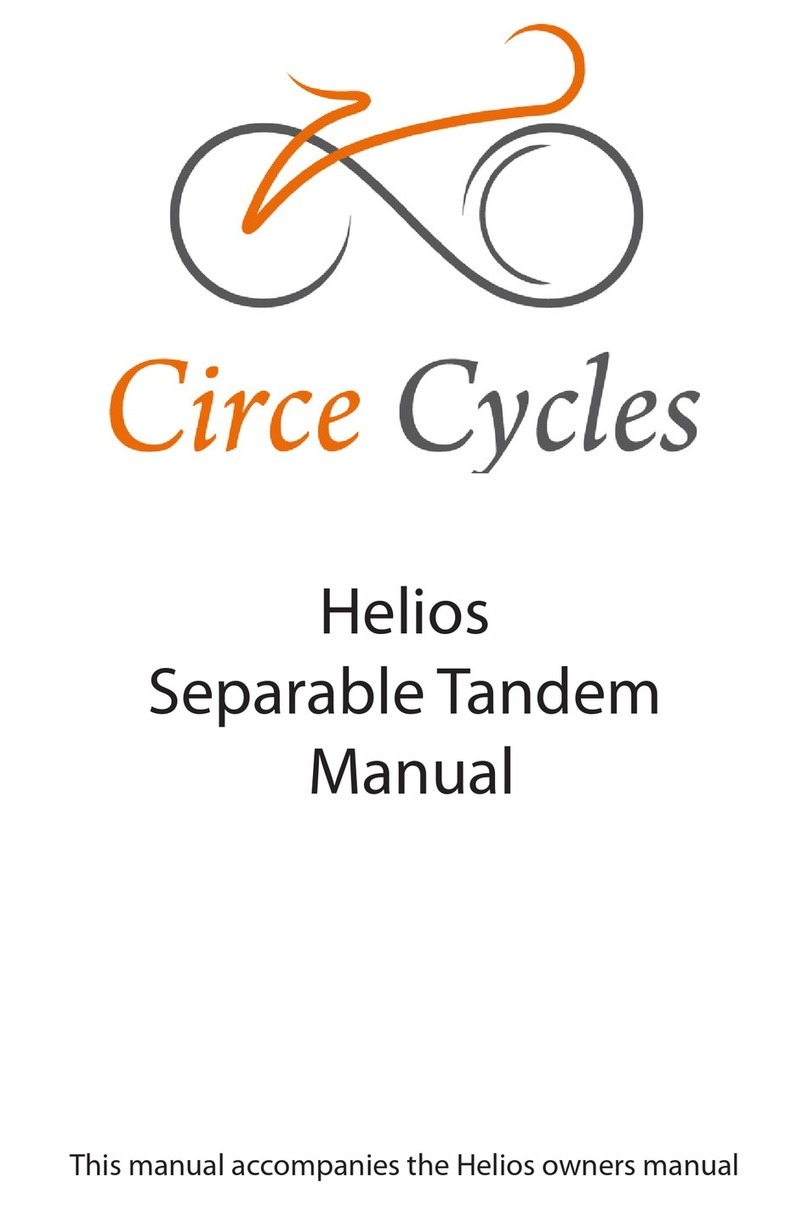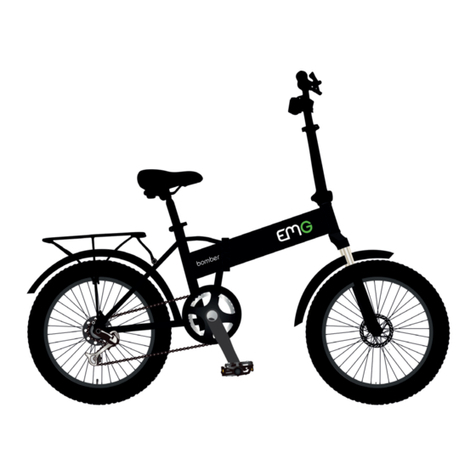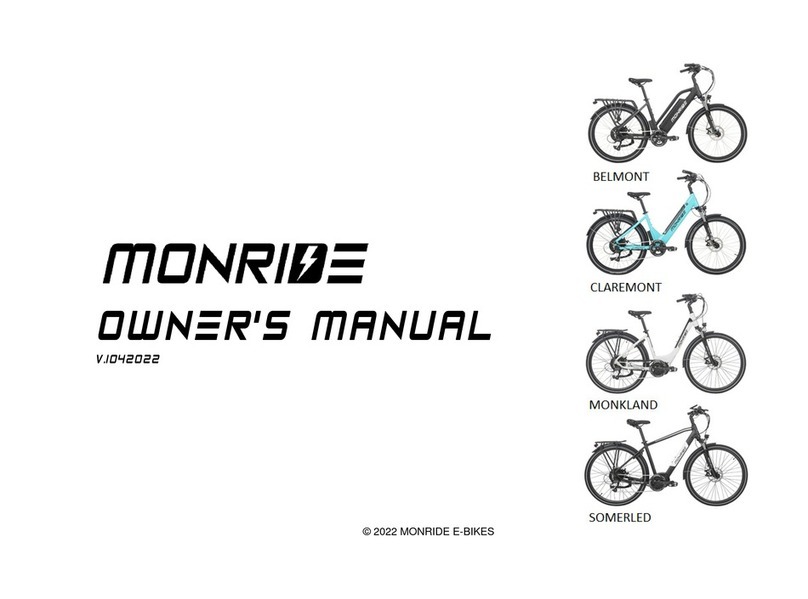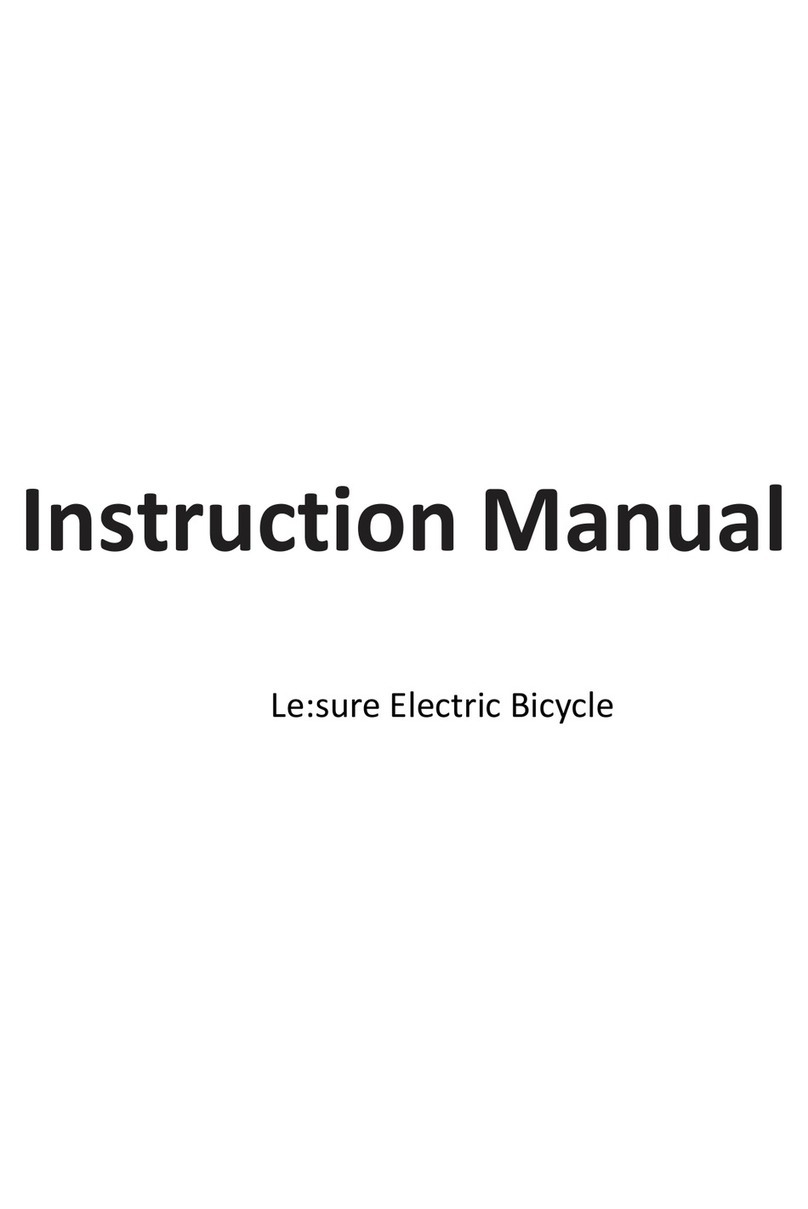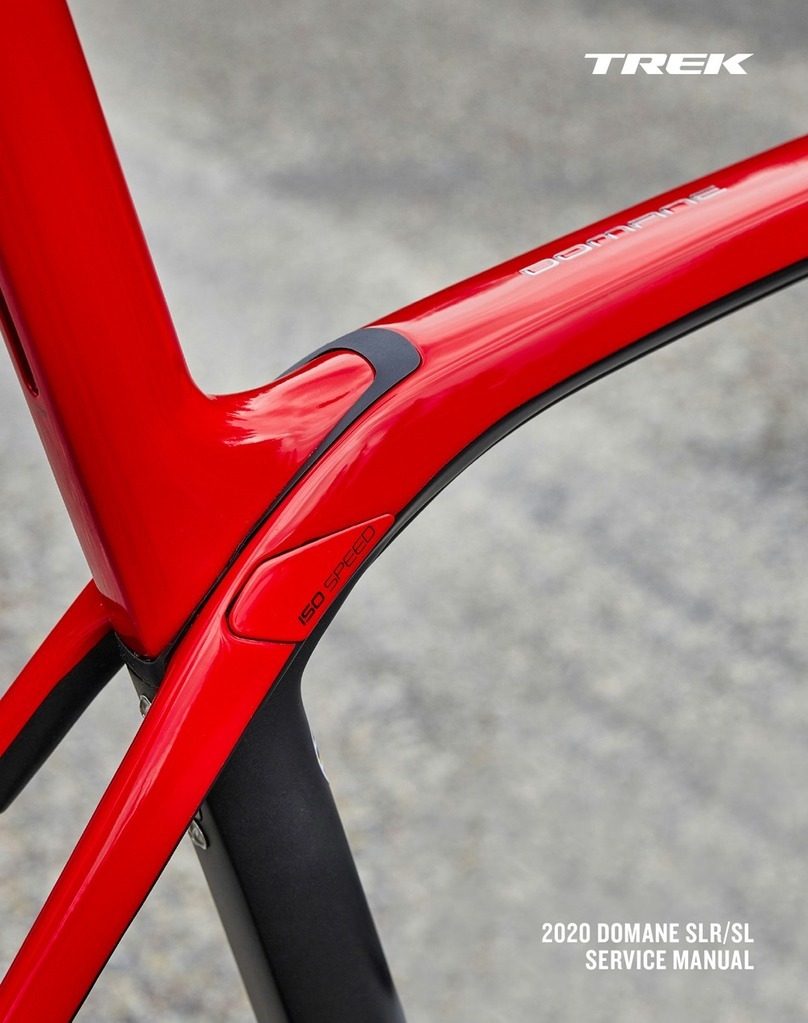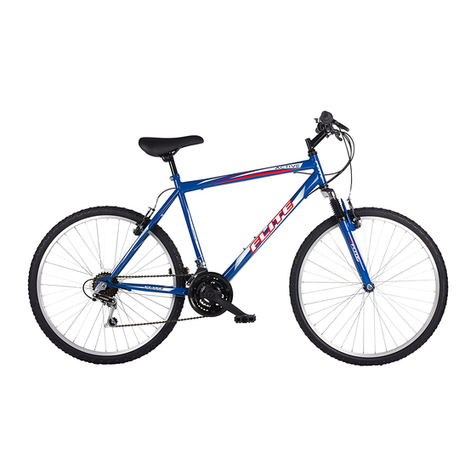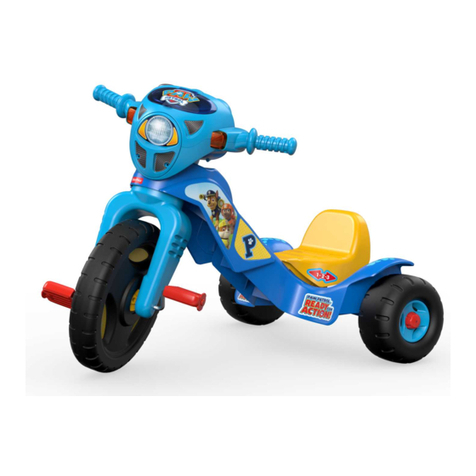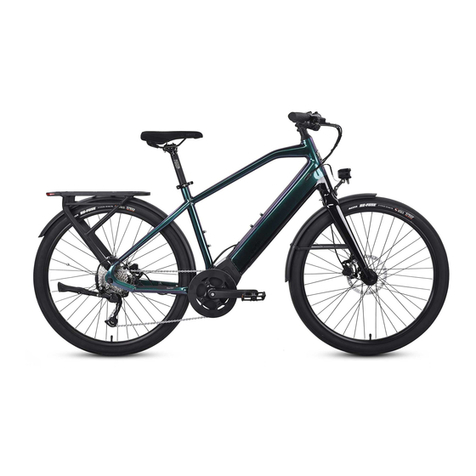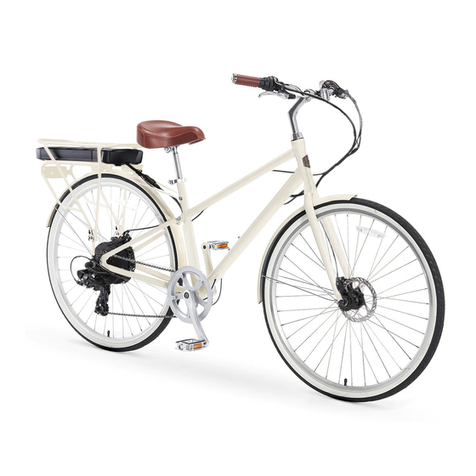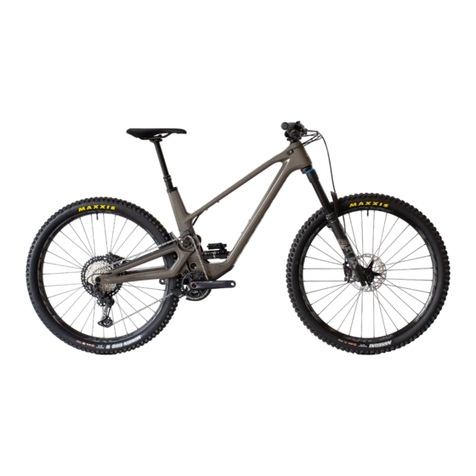Dawes Cycles FOLDING SERIES User manual

Owners Manual
FOLDING SERIES
folding bike manual.indd 1 20/06/2011 11:00:12

02
Contents
WARRANTY............................................................................................................................................................03
YOUR RESPONSIBILITY.......................................................................................................................................04
YOUR BIKE.............................................................................................................................................................05
FOLDING YOUR BIKE...........................................................................................................................................06
NIGHT RIDING.......................................................................................................................................................07
FIRST......................................................................................................................................................................08
SAFETY..................................................................................................................................................................09
FIT...........................................................................................................................................................................11
PEDAL FITMENT....................................................................................................................................................15
FOLDING YOUR PEDALS......................................................................................................................................17
SERVICE................................................................................................................................................................21
TORQUE VALUES.................................................................................................................................................25
folding bike manual.indd 2 20/06/2011 11:00:12

03
Warranty
All bikes must be registered within 14 days of purchase either online or by post using the form that is supplied with the cycle or on the Dawes website.
Failure to do this will result in the warranty being void.
For 3 years
All rigid alloy frames and forks
For 1 Year
All suspension frames, all paintwork and decals
All carbon fibre frames and forks, all original parts, suspension forks and rear suspension units unless these parts are covered in service by a UK
distributor.
Non-Dawes branded components
All non-branded Dawes components such as Rockshox, Shimano, Avid and SR Suntour are all covered by the original manufacturer’s warranty.
Whenever a fault occurs to a non-Dawes branded product you should contact the UK distributor for that brand to arrange a replacement or repair.
This warranty does not cover
Normal wear and tear proper assembly
Improper follow up maintenance
Installation of parts or accessories not originally intended for, or compatible with, the bicycle sold.
Damage or failure due to accident, misuse, excessive load, abuse or neglect.
Labour and transportation charges for the part replacement or changeover.
This warranty is applicable from the date of purchase for the original owner only, who must produce proof of purchase and register their cycle in order to
validate any claim. Claims must be submitted through your original retailer, unless the original retailer is no longer trading or no longer a Dawes dealer.
No bike is indestructible and no claims will be accepted for damage due to improper use, competition use, stunt riding, ramp jumping, leaping or similar
activities. Our bikes conform to the BS 6102/1: 1992 and BS EN 14766:2005 Mountain bicycles, BS EN 14764: City and trekking bicycles, BS EN
14781: Racing bicycles and EN 14765: Bicycles for young children (size 435mm-635mm, seat height to ground).
The company reserves the right to change or amend any specification without notice. All information and specifications within this brochure are correct
at time of printing. Please refer to our website for the latest information: www.dawescycles.com
Dawes Cycles, 35 Tameside Drive, Castle Bromwich, Birmingham, B35 7AG, Tel: 0121 748 8050 Fax 0121 748 8060
folding bike manual.indd 3 20/06/2011 11:00:12

04
In this leaflet we describe and illustrate how to ride safely and keep your bicycle in a safe, trouble free operating condition.
Owner’s Responsibility and Important Points - These are clearly marked to indicate that it has been manufactured to conform to one of four new
European bicycle safety standards, these standards have been developed and introduced into Europe and the UK to ensure that bicycles manufactured
in compliance with them will be as safe as is practically possible, please refer to the BS EN sticker on your bicycle frame for the relevant safety
standard. Before you ride your bicycle ensure that you are fully aware as to the type of use and the specification BS EN safety standard that your new
bicycle has been designed and manufactured to by understanding the specific usage descriptions given below.
BS EN 14764 City & Trekking Bicycles – (permissible total weight of rider + luggage + bicycle = 105kg)
These bicycles are intended for use on public roads, paths or cycle tracks that are in good condition. Check with your dealer or manufacturer with regard
to the suitability of your bicycle for such conditions and carry out maintenance checks as advised within this manual.
Your Responsibility
folding bike manual.indd 4 20/06/2011 11:00:12

05
Your Bike
1 2
4
3
5
6
1. Handlepost adjustment
quick release
2. Handlebar quick release*
3. Brake lever
4. Handlepost latch
5. Frame latch
6. Seat post quick release
*Fitted to selected models only
folding bike manual.indd 5 20/06/2011 11:00:16

06
• Loosen the quick release lever that secures
the handlebar*. (see image 1)
• Grip the handlebar and rotate the handlebar
anti-clockwise so the brake levers point
vertically. (see image 2)
• Using the quick release lever located on the
stem, raise the stem to the minimum insertion
mark. This will allow the handlebar to clear the
front axle once folded.
• Lift the small catch located on the handlebar
latch and pull the latch towards you. (see
image 3)
• Make sure to pull the latch so that the hook
releases from the stem. (See image 4)
• Fold the handlebar down.
• Squeeze the internal section of the pedal and
push down to fold the pedals.
• Loosen the quick release seat clamp and
lower the saddle to its lowest point, tighten the
quick release again to secure the seatpost.
• Rotate the small plastic retaining clip on the
frame latch to allow the lever to be released.
Now open the frame latch so it is fully open.
(see image 5)
1.
3.
4.
Folding your bike
• Make sure to open the frame latch as far as possible
as the latch features a double locking catch that will
automatically release when the frame latch is open
fully.
• Now fold the frame in half until the frame magnets*
located on the front fork and rear dropout connect.
5.
2.
*Fitted on selected models only.
folding bike manual.indd 6 20/06/2011 11:00:19

07
Riding a bike at night requires the rider to be more alert than riding during the day. A cyclist can be very difficult for motorists and pedestrians to see.
Riders should ensure that their bikes are well illuminated and that reflective clothing is used. Please consult your local dealer for more information
regarding riding at night.
WARNING- Reflectors are not a substitute for required lights. Riding at dawn, dusk, night or any other times of poor visibility without an adequate
bicycle lighting system and without reflectors is dangerous and may result in serious injury or death.
Bicycle reflectors are designed to pick up and reflect car lights and streetlights in a way that may help you to be seen and recognised as a moving
cyclist.
CAUTION- Check reflectors and their mounting brackets regularly to make sure that they are clean, straight, unbroken and securely mounted. Have
your dealer replace damaged reflectors and straighten or tighten any that are bent or loose.
If you choose to ride under conditions of poor visibility, check and be sure you comply with all local laws about night riding, and take the following
strongly recommended additional precautions:
• Purchase and install a dynamo or battery powered head and taillight that meet all local regulatory requirements and provide adequate
visibility
• Wear light coloured, reflective clothing and accessories, such as a reflective vest, reflective arm and leg bands, reflective stripes on your
helmet, flashing lights attached to your body and/or your bicycle
• Make sure your clothing or anything you may be carrying on the bicycle does not obstruct a reflector or light and securely mounted reflectors
• Make sure that your bicycle is equipped correctly with reflectors
If riding in traffic
• Be predictable. Ride so that drivers can see you and predict your movements
• Be alert. Ride defensively and expect the unexpected
Night Riding
folding bike manual.indd 7 20/06/2011 11:00:19

08
All folding bicycles are intended for use on paved roads only. Folding bikes are not intended for use trails, and should not be used for jumps, stunts or
other extreme sports. Make sure your bicycle is used for its intended purpose as the misuse may lead to the failure of some component or part.
Bike Fit
• Is the bike the right size? If your bicycle is too large or too small for you, it may cause you to lose control and fall. If your new bike is not the
right size, ask your dealer to exchange it before you ride it.
• Is the saddle at the right height? If you adjust your saddle height follow the minimum insertion instructions on page 11
• Are the saddle and seatpost securely clamped? A correctly tightened saddle will allow no saddle movement in any direction.
• Are the stem and handlebars at the right height for you? If not see page 12. Can you comfortably operate the brakes? If not you may be
able to adjust the angle and reach
• Do you fully understand how to operate your new bicycle? If not, before your first ride, have your dealer explain any functions or features that
you do not understand
Safety First
• Always wear an approved helmet when riding your bike and follow the helmet manufacturer’s instructions for fit, use and care
• Do you have all the other required and recommended safety equipment? It’s your responsibility to familiarise yourself with the laws of the
area where you ride and to comply with all applicable laws
• Riders weight and luggage should not exceed 105kg (230lbs)
• Are the wheel rims clean and undamaged? Make sure the rims are clean and undamaged along the braking surface and check for excess
rim wear. Periodically inspect your rims for excessive wear and if you have any question on whether or not your rims are safe, have them
inspected by a bicycle dealer
• Handlebar and saddle alignment. Make sure the saddle and handlebar stem are parallel to the bike’s centreline and clamped tight enough so
that you can’t twist them out of alignment
• Handlebar ends. Make sure the handlebar grips are secure and in good condition. If not, have your dealer replace them. Make sure the
handlebar ends are plugged. If not, have your dealer plug them before you ride.
This Manual
This manual is not intended as a comprehensive guide to bicycling and maintenance. It cannot teach you all the mechanical skills you need to repair
a bicycle nor can it teach you all the skills you will need to ride a bicycle. This manual has a great number of tips and advice for the specific bikes it
comes with. If you are ever unsure of how to maintain your bike, visit a dealer and ask for advice.
First
folding bike manual.indd 8 20/06/2011 11:00:19

09
The Basics
Warning- It is your responsibility to familiarise yourself with the laws where you ride and to comply with all applicable laws, including properly equipping
yourself and your bike as the law requires.
Observe all local bicycle laws and regulations. Observe regulations about bicycle lighting, licensing of bicycles, riding on pavement, laws regulating bike
path and trail use, helmet laws, child carrier laws, and special bicycle traffic laws. It is your responsibility to know and obey your country’s laws.
• Always check the safety of your bike before you ride it
• Be thoroughly familiar with the controls of your bicycle: brake (page 13), pedals (page 6 & 16), shifting (page 17)
• Be careful to keep body parts and other objects away from the sharp teeth of chain rings, the moving chain, the turning pedals and cranks,
and the spinning wheels of your bicycle.
Riding Safety
• You are sharing the road or path with others – motorists, pedestrians and other cyclists. Respect their rights
• Ride defensively. Always assume that others cannot see you
• Look ahead and be ready to avoid
• Vehicles slowing or turning, entering the road or your lane ahead of you, or coming up behind you
• Parked car doors opening
• Pedestrians stepping out
• Children or pets playing near the road
• Potholes, sewer gratings, railroad tracks, expansion joints, road or pavement construction, debris and other obstacles
• Ride in designated bike lanes, on designated bike paths or as close to the edge of the road as possible, in the direction of the traffic flow or as
directed by local governing laws
• Stop at stop signs and traffic lights; slow down and look both ways at street junctions.
• Use approved hand signals for turning and stopping
• Never ride with headphones
• Never carry a passenger
• Never hitch a ride by holding on to another vehicle
• Don’t weave through traffic or make unexpected moves
• Observe and yield the right of way
• Never ride your bicycle while under the influence of alcohol or drugs
Safety
folding bike manual.indd 9 20/06/2011 11:00:19

10
• If possible, avoid riding in bad weather, when visibility is obscured, at dawn, dusk or in the dark, or when extremely tired. Each of these
conditions increases the risk of accident
Wet Weather Riding
Warning- Wet weather impairs traction, braking and visibility, both for the bicyclist and for other vehicles sharing the road. The risk of an accident is
dramatically increased in wet conditions.
Under wet conditions, the stopping power of your brakes (as well as the brakes of other vehicles sharing the road) is dramatically reduced and your
tyres don’t grip nearly as well. This makes it harder to control speed and easier to lose control. To make sure that you can slow down and stop safely in
wet conditions, ride more slowly and apply your brakes earlier and more gradually than you would under normal dry conditions.
Safety continued
folding bike manual.indd 10 20/06/2011 11:00:19

11
Fit
Saddle Position
Correct saddle adjustment is an important factor in getting the most performance and comfort from your bicycle. If the saddle position is not comfortable
for you, see your dealer.
1. The saddle can be adjusted in three directions. 1) Up and down, 2) Front and back, 3) Saddle angle
Up and down adjustment
To check for the correct saddle height:
• Sit on the saddle
• Place one heel on a pedal
• Rotate the crank until the pedal with your heel on it is in the down position and the crank arm is parallel to the seat tube
If your leg is not completely straight, your saddle needs to be adjusted. If your hips must rock for the heel to reach the pedal, the saddle is too high. If
your leg is bent at the knee with your heel on the pedal, the saddle is too low.
Once the saddle is at the correct height, make sure that the seat post does not project from the frame beyond its “Minimum Insertion” or “Maximum
Extension” mark.
Warning- If the seat post projects from the frame beyond the “Minimum Insertion or “Maximum Extension” mark, the seat post may break, which could
cause you to lose control and fall.
Front and back adjustment.
The saddle can be adjusted forward or backward to help you get the optimal position on the bike. Ask your dealer to set the saddle for your
optimal riding.
Saddle angle adjustment.
Most people prefer a horizontal saddle; but some riders like the saddle nose angled up or down just a little. Your dealer can adjust the saddle
angle.
Small changes in the saddle position can have a substantial effect on performance and comfort. To find your best saddle position, make only one
adjustment at a time.
Warning- After any saddle adjustment, be sure that the saddle adjusting mechanism is properly tightened before riding. A loose saddle clamp or seat
post binder can cause damage to the seat post, or can cause you to lose control and fall. A correctly tightened saddle adjusting mechanism will allow
no saddle movement in any direction. Periodically check to make sure that the saddle adjusting mechanism is properly tightened.
folding bike manual.indd 11 20/06/2011 11:00:19

12
Handlebar Height and Angle
Warning- The handlepost “Minimum Insertion” mark must not be visible above the top of the headset. If the handlepost is extended beyond the
“Minimum Insertion” mark the stem may break or damage the steerer tube, which could cause you to lose control and fall.
Handlebar Position
The position of the handlebar should be set to allow comfortable and easy reach of both gear and brake levers. When riding, your weight should be so
balanced that your hands rest lightly on the handlebars. This prevents strain on your wrists and forearms when pedalling. If you alter the riding position,
remember to tighten all nuts and bolts securely.
Refer to the recommended torque values on page 24
Fit continued
folding bike manual.indd 12 20/06/2011 11:00:19

13
Brakes
Riding with improperly adjusted brakes or worn brake pads is dangerous and can result in serious injury or death.
Applying brakes too hard or too suddenly can lock up a wheel, which could cause you to lose control and fall. Sudden or excessive application of the
front brake may pitch the rider over the handlebars, which may result in injury or death.
Some bicycle brakes, such as linear-pull brakes (V-brakes) are extremely powerful. Exercise particular care when using them.
See the manufacturer’s instructions for operation and care of your brakes. If you do not have manufacturer instructions, contact your dealer or brake
manufacturer.
Brake controls and features
It’s very important to learn and remember which brake lever controls what brake. Your bike will come already set and adjusted so that the left brake
lever controls the rear brake. The right lever controls the front brake. Make sure your hands can reach and squeeze the brake levers.
How brakes work
The action of a rim-actuated brake on a bicycle is a function of the friction between the brake surfaces – usually the brake pads and wheel rim. To make
sure that you have maximum friction available, keep your wheel rims and brake pads clean and free of dirt, lubricants, waxes or polishes.
Brakes are designed to control your speed, not just stop the bike. Maximum braking force for each wheel occurs at the point just before the wheel
“locks up” (stops rotating) and starts to skid. Once the tyres skid, you actually lose most of your stopping force and completely lose directional control.
Note- Make sure that no oil or lubrication touches your brake pads or the bicycles rims braking surfaces. Please replace worn brake shoes only with
factory authorized brake replacements.
Caution- Before riding test your brakes. Make sure that the quick release mechanism is returned to its normal correct position; otherwise your brakes
will not operate effectively.
Brake block replacement- V-Brakes
All brake blocks are provided with grooves that indicate the wear on each block. When the grooves are worn down to a flat surface, replace the blocks
(in pairs) immediately.
folding bike manual.indd 13 20/06/2011 11:00:19

14
V-Brake System
Inner Cable Quick Release
To Release the brake inner cable from the V - brake, squeeze the two brake arms together until the brake blocks contact the rim and remove the inner
cable pipe from the cable end bracket. To re-connect again squeeze the two brake arms together and relocate the inner cable pipe in the cable end
bracket.
Inner Cable Adjustment
1. Pass the inner cable through the inner cable lead, and
after setting so that the total of the clearances between
the left and right shoes and the rim is 2mm, tighten the
cable-fixing bolt.
2. Adjust the balance with the spring tension
adjustment screws.
3. Depress the brake lever about 10 times as in
normal brake operation and check that everything is
operating correctly and the shoe clearance is
correct before using the brakes. Reset rear brake
quick release mechanism and check brake for proper
operation
Depress about
10 times
Cable Fixing
Bolt
Inner Cable Lead
Pipe
folding bike manual.indd 14 20/06/2011 11:00:19

15
Rim Wear Line Limit Indicator
Visible safety line
This type of safety line is already machined and is visible in the aluminium braking surface. When the rim has been subjected to extended braking and
the rim surface is sufficiently worn to warrant replacement, the safety line will disappear and the rims braking surface will be one continuous smooth
surface.
THE RIM MUST BE REPLACED BY A PROFESSIONAL CYCLE MECHANIC BEFORE THE BIKE IS RIDDEN.
Warning- Do not attempt to ride the cycle until you are absolutely sure that all quick release levers are fully closed and securely tightened.
Fitment of Bell
1 Remove the screw from bell clamp
2 Position in a convenient spot near the left hand or right hand handlebar grip.
3 Replace screw & tighten
4 Rotate the “Ping Arm” to a comfortable position.
Ping Arm
Brake Lever/Shifter
Grip
Position bell on left hand or right hand
side of the handlebar as required.
folding bike manual.indd 15 20/06/2011 11:00:19

16
R
Tighten Clockwise
L
Tighten Anti-clockwise
TO FIT RIGHTHAND PEDAL
TO FIT LEFTHAND PEDAL
3. Locate thread by hand, fit
and tighten.
4. Use spanner to finish
tightening (be careful)
1. Fit to non chainside of cycle.
2. The pedal has a special
thread to tighten in an anti-
clockwise direction,
towards the front of the
bicycle.
3. Locate thread by hand, fit
and tighten.
4. Use spanner to finish
tightening (be careful)
Check for the letters “L”or “R” on the ends of the pedals to show which side the pedal needs to be fitted to.
RL
RL
WARNING
Pedal Fitment
folding bike manual.indd 16 20/06/2011 11:00:19

17
Folding your pedals
To fold the pedals on your bike, do the following:
1. Squeeze the internal section of the pedal. Shown in grey on Fig A
2. Whilst still squeezing the internal section push the pedal down. Shown in grey on Fig B
To unfold the pedal pull the pedal body up and the pedal will click back into place.
WARNING- The pedals contain a spring to assist the folding mechanism. Please keep a firm
grip of the pedal when folding and unfolding.
FOLD FOLD
Fig A Fig B
folding bike manual.indd 17 20/06/2011 11:00:20

18
Shifting Gears
Your multi-speed bicycle will have a derailleur drive train, an internal gear hub drive train or in some special cases a combination of the two.
How a Derailleur Drive Train Works
If your bicycle has a derailleur drive train, the gear changing mechanism will have:
• A rear cassette or freewheel sprocket cluster
• A rear derailleur
• Usually a front derailleur
• One of two shifters
• One, two or three front sprockets called chain rings
• A chain drive
Shifting Gears
There are several different types and styles of shifting controls, levers, twist grips, triggers, combination shift/brake controls and push buttons. Ask your
dealer to explain the type of shifting controls that are on your bike, and to show you how they work.
A downshift is a shift to a “lower” or “slower” gear, one that is easier to pedal. An upshift is a shift to a “higher” or “faster” harder to pedal gear. To
select a gear that will make pedalling easier on a hill, make a downshift in one or two ways; shift the chain down (the gear “steps” to a smaller gear at
the front) or shift the chain up (the gear “steps” up to a larger gear at the rear). So at the rear gear cluster, what is called a downshift actually moves the
chain up to a larger gear. The way to keep things straight is to remember that shifting the chain in towards the centre line of the bike is for accelerating
and climbing and is called a downshift. Moving the chain our or away from the centre line of the bike is for speed and is called an upshift.
Whether upshifting or downshifting, the bicycle derailleur system design requires that the drive chain be moving forward and be under at least some
tension. A derailleur will shift only if you are pedalling forward.
Shifting the Rear Derailleur
The right shifter controls the rear derailleur.
The function of the rear derailleur is to move the drive chain from one gear sprocket to another. The smaller sprockets on the rear wheel gear cluster
produce higher gear ratios. Pedalling in the higher gears requires greater pedalling effort, but takes you a greater distance with each revolution of the
pedal cranks. Using them requires less pedalling effort, but takes you a shorter distance with each pedal crank revolution. There are two screws or limit
screws on the rear derailleur body that limit the travel of the rear derailleur. Tightening the rear derailleur high gear adjustment screw keeps the chain
folding bike manual.indd 18 20/06/2011 11:00:20

19
from shifting off the small (high) gear that is on the rear axle. Tightening the rear derailleur low gear adjustment screw keeps the chain from shifting off
the large (low) gear into the rear wheel. Moving the chain from a smaller sprocket of the gear cluster to a larger sprocket results in a downshift. Moving
the chain from a smaller sprocket on the chain rings to a larger sprocket results in what is called an “upshift”. In order for the derailleur to move the
chain from one sprocket to another, the rider must be pedalling forward.
Which Gear Should I Be In?
The combination of largest rear and smallest front gears is for the steepest hills. The smallest rear and largest front combination is for the great-
est speed. It is not necessary to shift gears in sequence. Instead, find the “starting gear” which is right for your level of ability – a gear which is hard
enough to let you start from a stop without wobbling – and experiment with upshifting and downshifting to get a feel for the different gear combinations.
At first, practice shifting where there are no obstacles, hazards or other traffic, until you’ve built up your confidence. Learn how to anticipate the need to
shift, and shift tot a lower gear before the hill gets too steep. If you have difficulties with shifting, the problem could be mechanical adjustment. See your
dealer for help.
How an Internal Gear Hub Drive Train Works
If your bicycle has an internal gear hub drive train, the gear changing mechanism will consist of
• A 3, 5, 7, 8 speed internal gear hub
• One or sometimes two shifters
• One or two central cables
• One front sprocket called a chain ring
• A drive train
Shifting Internal Gear Hub Gears
Shifting with an internal gear hub drive train is simply a matter of moving the shifter to the indicated position for the desired gear. After you have moved
the shifter to the gear position of your choice, ease the pressure on the pedals for an instant to allow the hub to complete the shift.
Which Gear Should I Be In?
The numerically lowest gear (1) is for the steepest hills. The numerically largest gear (3, 5, 7 or 12 depending on the number of speeds of your hub) is
for the greatest speed.
folding bike manual.indd 19 20/06/2011 11:00:20

20
Chains
Single-speed and three-speed bicycles as well as many IGH (Internal Geared Hubs) equipped bicycles use a “1/2 x 1/8” chain that has a master link.
To reinstall the “1/2 x 1/8” chain, turn the bicycle upside down and after reinstalling the chain, pull the rear wheel axle in a rearward direction.
With rotation of the chain, any “tight spot” and a “loose spot” are due to inconsistent chain wheel roundness. Adjust the chain so there is no looseness
when the chain is in one of its “tight spots.”
Derailleur equipped bicycles use a narrower “1/2 x 3/32” chain that has no master link. With a “1/2 x 3/32” chain, it is necessary most of the time to
use a special tool to push a link pin out of the chain to separate and remove it. There are many methods of measuring the chain to determine if it is too
worn. There are some excellent chain wear indicators for sale at bike shops. Since the chain rotates a lot more on the rear wheel than the front, please
note that replacing the already badly worn chain may mean that you might also need to replace the rear wheel cassette or freewheel as well.
Transporting your Bike
Our suggestion for commuting and medium distance travel is that it is best to use a nylon carry bag.
Carrying
Carrying a 20-inch wheeled folding bicycle is quite easy for extra short to medium distance solutions. Simply grab the bicycle and carry by the saddles
edge. When crossing a threshold, boarding a bus, train or airplane or stowing away the bike in an overhead compartment you will need to pick your
bicycle up. When the occasion arises that you need to travel or commute and want your bicycle with you, feel confident knowing your bike is ready
when you are. As 24” wheel folding bikes are larger than the 20” version they may have limited carrying and fit ability in public conveyance overhead
compartments.
folding bike manual.indd 20 20/06/2011 11:00:20
Table of contents
Other Dawes Cycles Bicycle manuals
